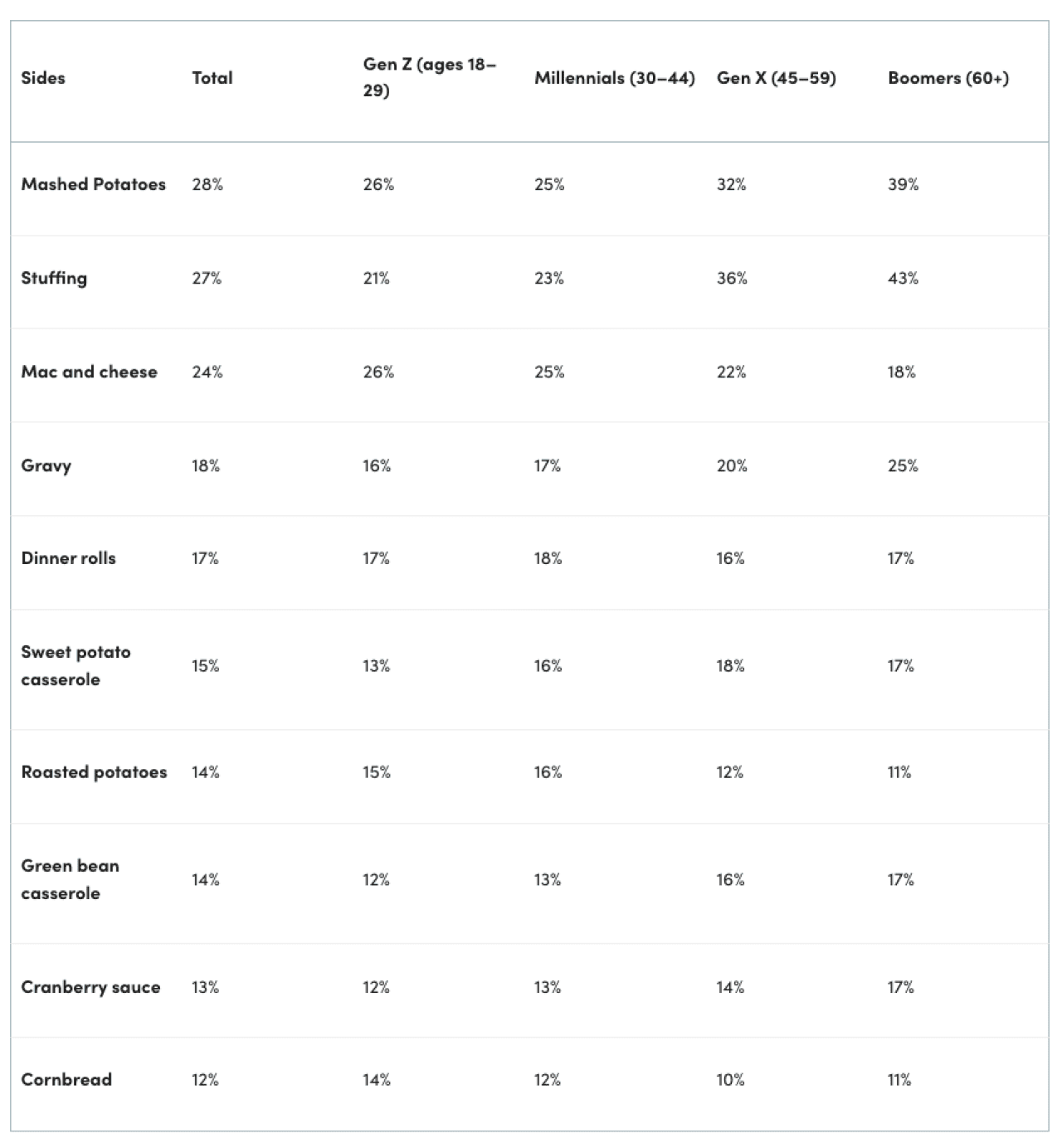Gen Z says stuffing is for Boomers: Here’s what they’re serving instead for Thanksgiving
Lifestyle

Audio By Carbonatix
1:31 PM on Thursday, November 20
By Melissa Lavigne-Delville for Hers, Stacker
Gen Z says stuffing is for Boomers: Here’s what they’re serving instead for Thanksgiving
Get ready, America: Thanksgiving is getting a Gen Z makeover. A recent Hims & Hers study investigated which Thanksgiving side dishes various generations love most. According to results, which Hers examines here, it seems that the classic plate of turkey, mashed potatoes, stuffing, and gravy that typically dominates dinner tables for the holiday is getting an update — and some classic side dishes are on the generational chopping block.
Mac and Cheese Is ‘In’ — Stuffing Is ‘Out’
At first glance, America’s favorite Thanksgiving side dishes don’t look very different from how they looked in the past. Mashed potatoes take the top spot as America’s favorite side dish, followed closely by stuffing. Other traditional sides like gravy, dinner rolls, and sweet potato casserole also ranked highly.
However, the study results highlight a clear divide in side dish preferences between younger and older generations. Specifically, the most pronounced preference gap is between the youngest generation we surveyed — Gen Zs, those aged 18 to 29 — and the oldest — baby boomers, those aged 60 and up.
43% of baby boomers name stuffing as a favorite side dish compared to just 21% of Gen Zs
Mac and cheese ranked as Gen Z’s top side dish, with 26% of respondents from the generation naming it their favorite, and only 18% of baby boomers placed the cheesy side at the top of their list. By contrast, 43% of baby boomers named stuffing as their Thanksgiving side, while only 21% of Gen Z called the holiday classic their favorite.
Top 10 Favorite Thanksgiving Sides, Ranked by Generation

So how do you bring generations together at the Thanksgiving table? Mashed potatoes. The classic Thanksgiving side is still an American favorite, no matter who’s eating: It ranked in the top two spots among all generations.
Sides Are Becoming More Culturally Rooted and Digitally Influenced
Thanksgiving dishes are diversifying beyond classic dishes among younger generations to include more cultural nuance. Notably, Gen Z respondents were two times more likely than boomers to name “a dish specific to my culture” as a favorite (9% versus 4%).
Certain globally influenced dishes like curried butternut squash are finding their way onto many holiday tables. And some are swapping out the classic centerpiece of American Thanksgiving — turkey — for alternative meat or no meat at all, perhaps catering to the population of Gen Z folks who follow vegetarian, vegan, or flexitarian diets.
Gen Z respondents were two times more likely than boomers to name “a dish specific to my culture” as a favorite (9% versus 4%)
Key Differences by State
Generational differences aside, Thanksgiving also looks different depending on the state where you are celebrating. Cornbread is nearly twice as likely to be served on Thanksgiving tables in Georgia as in the rest of the country (20% of Georgians name it as a favorite versus 12% of Americans overall). And you are five times more likely to have cranberry sauce in South Carolina (21% say it’s a favorite) than in Colorado, where only 4% of people like the tangy sauce.
One surprise is that Idaho, a state known for its potatoes, isn’t necessarily eating them on Thanksgiving. In fact, more Idahoans name mac and cheese as a favorite than mashed potatoes (28% versus 27%), and only 14% of respondents are serving roasted potatoes on Thanksgiving day. For roasted potatoes, specifically, head to Kansas — the only state where the dish took first place for favorite side (23%).
How to Give Health a Seat at the Thanksgiving Table
When it comes to nutrient-rich Thanksgiving side dishes, Vermont and Delaware got top marks. Folks in both states share a taste for roasted vegetables, with Delaware two times more likely than the national average to serve roasted Brussels sprouts (18% versus 9%, respectively) and Vermont nearly two times more likely to champion roasted or glazed veggies (18% versus 10% nationally). Both states were also twice as likely to opt for roasted pumpkin or butternut squash (15% versus 8% of America overall).
89% of Americans are willing to swap out a Thanksgiving side for a healthier alternative.
In general, the survey found that Americans are open to making some healthy Thanksgiving swaps: 89% of respondents said they’re willing to trade a traditional side for a healthier alternative.
But, no need to deprive yourself of a dish you love, even if it doesn’t have the richest health profile. Rather than skipping favorite sides altogether, consider the four tips below to help make them healthier.
1. Trash the Cans
To reduce the sodium and sugar content of your dishes, swap out your canned sides for fresh options.
2. Veg Out
Bulk up the vegetables in your dinner to increase your nutrient intake. This doesn’t mean replacing stuffing with salad, but for one idea, you might consider shifting your stuffing from a 100% bread base to a two-to-one vegetable-to-bread ratio. Doing so may help you maintain flavor while cutting carbohydrates.
3. Sub Away
Greek yogurt is just one healthy substitute to try out in your Thanksgiving side recipes, like America’s favorite—mashed potatoes. Low-sodium broth in gravy, wild rice in stuffing, and chickpea pasta in mac and cheese are other easy substitutes.
4. Air-Fry It
Lots of Thanksgiving side dishes are great air-fried. Brussels sprouts, potatoes, green beans, and cornbread are all good candidates for air-frying, which can help cut down on the oil required to pan-fry. This method saves oven and stove space, to boot.
Data and Methodology
This study is based on a 6,985-person online survey, which included approximately 5,000 18-to-65-year-old respondents in the top 50 metropolitan areas (100 respondents per city); 5,000 18-65-year-old respondents in each of the 50 states (100 respondents per state); and a nationally representative sample of 500 18-to-65-year-old respondents to contextualize results. These three categories are not mutually exclusive; some respondents fall within more than one category. The study was fielded in August 2025.
Findings were analyzed by more than 150 demographic and psychographic cuts, including city, region, gender (when the study refers to “women” and “men,” it includes all people who self-identify as such), age, race and ethnicity, relationship status, parenting status, sexual orientation (heterosexual, bisexual, gay, lesbian, pansexual, asexual, queer, etc.), fandoms (music, sports, etc.), and fitness and diet preferences, among other areas of interest.
All data in this study are from this source, unless otherwise noted. Independent research firm, Culture Co-op, conducted and analyzed research and findings.
This story was produced by Hers and reviewed and distributed by Stacker.





